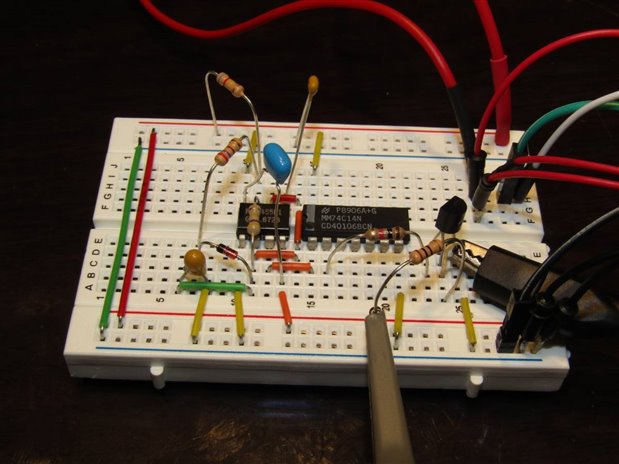Everyone is familiar with the USB Batteries that can be used to charge a cell phone and which can themselves be charged off a any standard USB port or charger. A while back I began using one type of these batteries to power some of my small projects and also I began to advocate their use to my friends for this purpose. Here are two of the many brands and types currently available.
For the rest of this Blog I will refer to them as "Black" and "Silver". My first experience with using these batteries for project power supplies was with Silver. Silver is typical in that it has a 3.7 volt Li-Ion cell at its heart which can be charged with a 5 volt charger and when off the charger and plugged into another device uses an internal boost DC to DC converter to deliver 5 volts output. When Silver is turned on and no load is present it will turn itself off after 60 seconds. When Silver is turned on under load it will maintain an on state as long as the load doesn't drop below 10 mA for more than 60 seconds. Its internal sensor sees loads less than 10 mA as no load and starts a shut down sequence. My experience with Silver as a power source for small projects has been excellent as I seldom build anything that operates at less than 10 mA.
It is our nature to generalize and true to my human nature I made the mistake of believing that all other types and brands of these devices would behave just like Silver.
Along came Black whose purpose was to power a small frequency counter kit that I built for a friend. Black it turns out is not like Silver. Black will automatically shut down after 18 seconds if it doesn't see a load. Further it turns out that the lower limit for the load that it can see is 75 mA. The small frequency counter did not draw anything near 75 mA and so every 18 seconds the battery needed to be turned back on which was not practical.
The other day in a Blog by fmilburn - Working Prototype of a Kelvin (4-Wire) Milliohm Meter the discussion morphed into some comments about using this type of battery pack for his portable milliohm meter. It was noted that there is a tendency for these batteries to shut off. In the discussion Frank mentioned that somewhere he had heard about a procedure to pulse the USB battery with a short moderate current load to keep it active.
I wanted to have the flexibility to use Black in future projects so I drew up a schematic and did some bench testing finally arrived at a bread board prototype:
Here is a schematic of this circuit:
This circuit has a quiescent current of 2.5 mA and produces a 3 millisecond load of 300 mA every ten seconds. Black which would normally turn off after 18 seconds with a load of less than 75 mA was perfectly happy to stay engaged and run for hours when attached to this circuit. The 10 second load pulse was within Black's 18 second window to shut down and apparently the 300 mA load was sufficient to restart the 18 second time limit.
While I hadn't had any problems with Silver I wanted to see if Silver would also respond to the pulsed load to reset its 60 second time out on loads of less than 10 mA. Unfortunately this was not to be. The (6) 300 mA loads that were put on Silver did not change its mind and after 60 seconds it promptly turned off.
I do not want to make the mistake of generalizing this situation again but I know there are at least 2 different situations when using USB batteries (Silver and Black) and I might extend this idea to say that there are likely many others. Here is my comparison of Silver and Black:
Battery Name Model & Brand Time to Shut Down (No Load) Minimun Stay On Load Does the Pulse Load Fix Work
Silver XPB15031S Unknown 60 Seconds 10 mA No
Black 16WMS137 Shen Zhen 18 Seconds 75 mA Yes
I am posting this blog in Test & Tools as I do not want it to belong to me but serve as a place were additional information on using USB batteries to power projects can be posted. If you have a USB battery, and are inclined to test it, any information you can supply would be appreciated. Short of loading the battery down with power wasting loads to keep them on what other schemes can we come up with? Is there a special magic circuit that will work to keep any USB battery engaged powering our small portable projects or will we have to design a specific remedy for each unique USB battery type?
Since the use of the USB battery technology can be a benefit to anyone wanting a convenient power source for small portable projects I welcome as many ideas and tested remedies as can be found.




Top Comments
-

Gough Lui
-
Cancel
-
Vote Up
+7
Vote Down
-
-
Sign in to reply
-
More
-
Cancel
-

jw0752
in reply to Gough Lui
-
Cancel
-
Vote Up
+5
Vote Down
-
-
Sign in to reply
-
More
-
Cancel
-

Gough Lui
in reply to jw0752
-
Cancel
-
Vote Up
+5
Vote Down
-
-
Sign in to reply
-
More
-
Cancel
Comment-

Gough Lui
in reply to jw0752
-
Cancel
-
Vote Up
+5
Vote Down
-
-
Sign in to reply
-
More
-
Cancel
Children